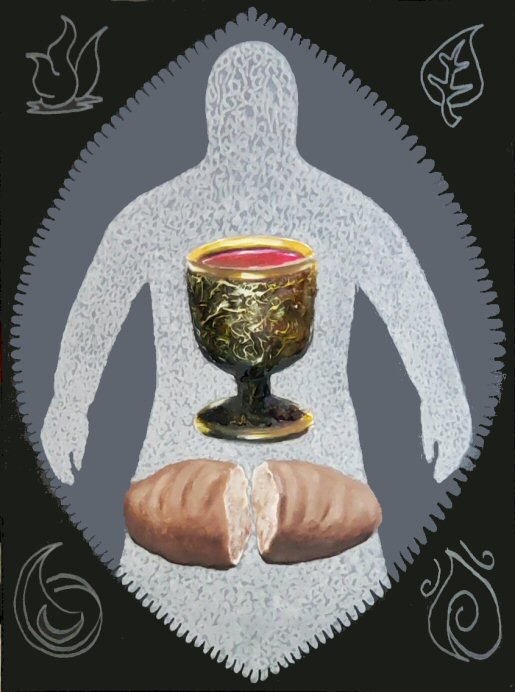|
The description of the Last Supper in which the Christ is said to have shared bread and wine with his disciples appears in Matthew, Mark, Luke, and the First Epistle to the Corinthians. The description in the Gospel of John differs from the others. It includes foot washing, a farewell speech, and commandments. The celebration of this event is called the Eucharist or Holy Communion and is a sacrament in most Christian churches. The word, Eucharist, means thanksgiving. Communion means the coming together of the people as one and that is the meaning I want to convey in this painting. What better way to teach us that we are all one than to have us symbolically eat and drink of one flesh and blood? As the saying goes, "we are what we eat." In partaking of the Communion elements, we are proclaiming our oneness with the Christ who is the revelation of our eternal salvation. Jesus revealed the truth about our relationship with others and with the Creator. He proclaimed that we are one!  In the painting, the image of the
Christ is composed of a large crowd of people which at
first probably appears to be nothing more than a
network of squiggly lines. This is an artistic
representation
of our oneness. In the painting, the image of the
Christ is composed of a large crowd of people which at
first probably appears to be nothing more than a
network of squiggly lines. This is an artistic
representation
of our oneness. The symbols at the corners of the picture stand for the four elements of classical antiquity: earth, air, fire, and water. These are symbolic of four states of being: solid matter, gas, energy, and liquid, There are also exactly four forces at work in the universe: gravity, electro-magnetic energy, the weak nuclear force, and the strong nuclear force. The symbols of the four ancient elements as well as the elliptical shape (called the mandorla which was used extensively in early Christian art up until the Renaissance) are artistic statements of the importance of the history of our understanding of the world. Too often we tend to dismiss many of the beliefs of the past, particularly scientific beliefs, as being based on ignorance -- especially when compared to our extensive scientific knowledge today. I believe we would benefit from a deeper appreciation of our history. Oftentimes the ancient ideas contained truths about ourselves and how we tend to think. Our history is part of who we are. May we all celebrate our Communion, the embracing of our oneness as revealed by Jesus!  CREATE A FREE ONLINE JOURNAL -- CLICK HERE or HERE  
   |
Copyright, James Bennett 2021
